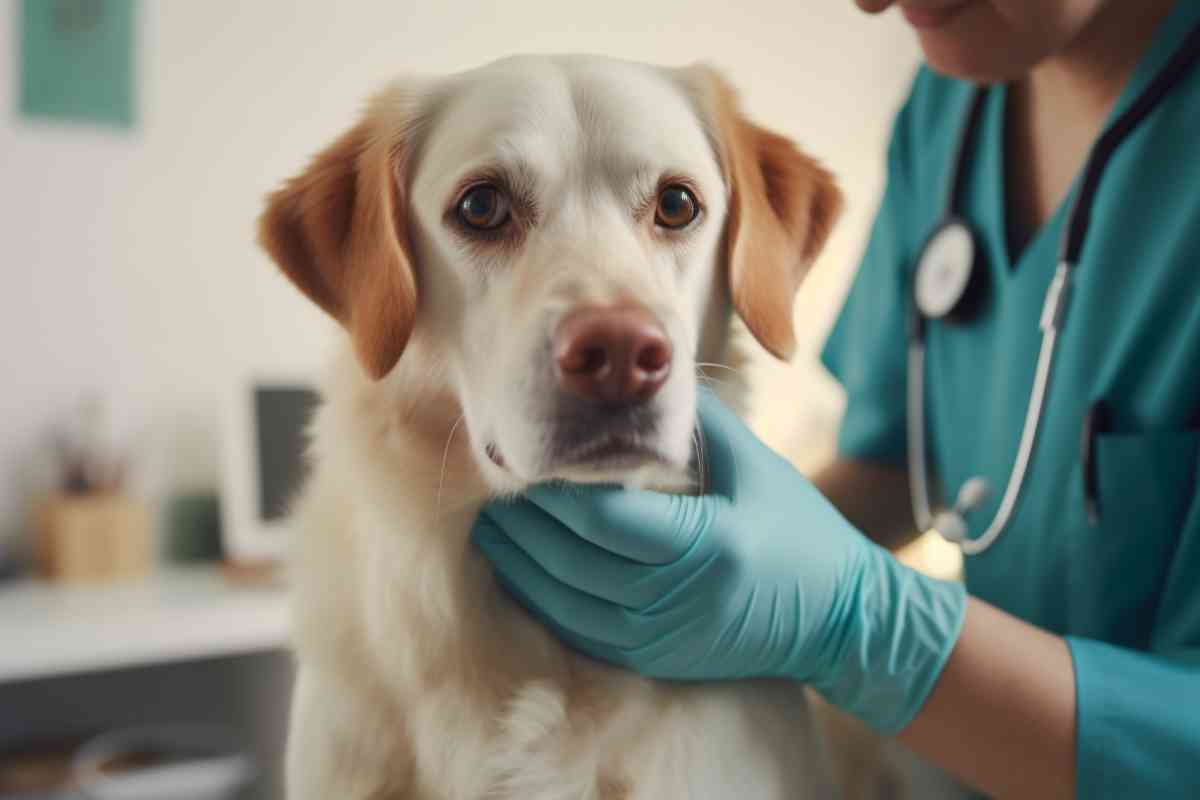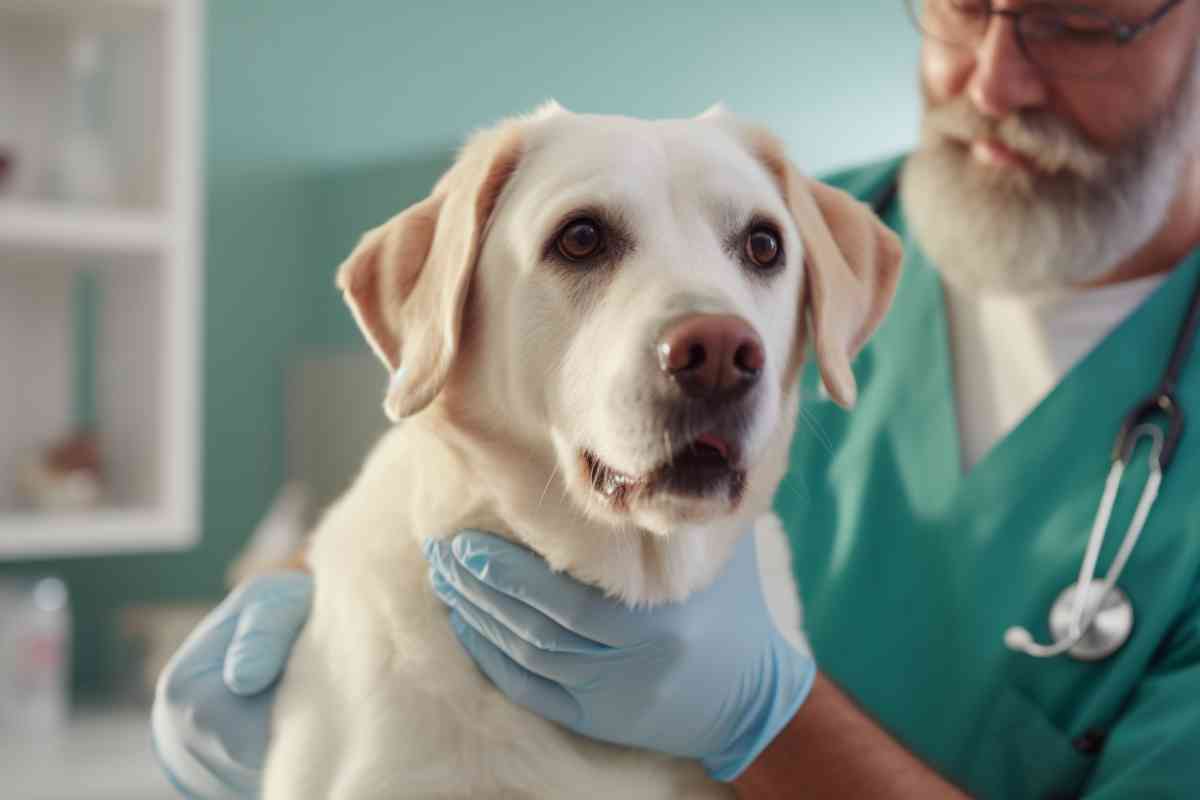Common Genetic Issues in Labrador Retrievers: A Comprehensive Guide
Labrador Retrievers are renowned for their loyalty, intelligence, and affable nature. They are genrally pretty healthy. However, the breeding process that has honed these admirable qualities over generations has also brought with it a susceptibility to some common genetic issues in labrador retrievers.

What are common genetic issues in Labrador Retrievers?
Labrador Retrievers are predisposed to several genetic issues, the most critical being hip and elbow dysplasia, which affect the joints, and eye conditions like Progressive Retinal Atrophy (PRA) that can lead to blindness. Other notable concerns include Exercise-Induced Collapse (EIC), a neuromuscular disorder, and Centronuclear Myopathy (CNM), which causes muscle wasting. Responsible breeding, which includes genetic testing to weed out these traits, is vital in ensuring the health and wellbeing of this beloved breed.
Here is a deep dive into the health concerns that Labrador Retrievers are prone to, from understanding the nuances of genetic disorders to the indispensable role of genetic testing in responsible breeding.
Related Posts:
- Are Labs Prone to Health Problems?
- Labrador Retriever Clubs and Associations: Where to Find the Best Resources for Your Furry Friend

Hip Dysplasia
Hip dysplasia is a common genetic issue found in Labrador Retrievers. It is a malformation of the hip joint, which can cause pain and discomfort, and can lead to arthritis.
Symptoms
Symptoms of hip dysplasia in Labrador Retrievers include limping, stiffness, bunny hopping gait, trouble getting up from a nap, and difficulty walking up or down stairs. If you notice any of these symptoms, it is important to take your dog to a veterinarian for a diagnosis.
Diagnosis
Diagnosis of hip dysplasia is typically done through x-ray imaging. The x-rays will show if there is any abnormality in the joint, such as a shallow socket or a loose joint.
Treatment
Treatment for hip dysplasia in Labrador Retrievers can vary depending on the severity of the condition. In mild cases, weight management and exercise restriction can help alleviate pain and discomfort.
In more severe cases, surgery may be necessary to correct the malformation of the joint. Pain management medication may also be prescribed to help manage pain and discomfort.

Elbow Dysplasia
Elbow dysplasia involves abnormal bone growth and cartilage development in the elbow joint, leading to lameness and pain.
Symptoms
The symptoms of elbow dysplasia can vary from mild to severe, and may include:
- Lameness, especially after exercise or play
- Stiffness in the affected limb
- Reluctance to move or climb stairs
- Pain when touched or manipulated
- Limited range of motion in the elbow joint
Diagnosis
Diagnosing elbow dysplasia in Labrador Retrievers usually involves a physical examination, X-rays, and sometimes additional imaging tests. The X-rays can reveal changes in the shape and structure of the elbow joint, such as fragmentation or sclerosis.
Treatment
Treatment for elbow dysplasia in Labrador Retrievers typically involves a combination of medication, exercise modification, and sometimes surgery.
Pain relief medication such as non-steroidal anti-inflammatory drugs (NSAIDs) can help manage the symptoms and improve mobility. Exercise modification may include reducing the intensity and duration of exercise, and avoiding activities that put excessive strain on the affected joint.
In severe cases, surgery may be necessary to remove fragments of bone or cartilage, or to realign the joint.

Progressive Retinal Atrophy (PRA)
Progressive Retinal Atrophy (PRA) is a group of inherited eye diseases that result in the gradual degeneration of the retina, leading to blindness in dogs. Labrador Retrievers are among the breeds that are commonly affected by PRA.
Symptoms
The symptoms of PRA in Labrador Retrievers can vary depending on the type of PRA. However, some common signs to look out for include:
- Night blindness
- Dilated pupils
- Cloudy eyes
- Bumping into objects
- Reluctance to go outside in bright light
Diagnosis
A veterinary ophthalmologist can diagnose PRA through a comprehensive eye exam, which may include electroretinography (ERG) and genetic testing.
ERG measures the electrical activity of the retina in response to light, while genetic testing can identify the specific gene mutation responsible for PRA in a dog.
Treatment
Unfortunately, there is currently no cure for PRA, and once a dog loses their vision, it cannot be restored. However, there are some steps that can be taken to help a blind dog adjust to their new lifestyle. These may include:
- Keeping the environment consistent to help the dog navigate more easily
- Using verbal cues to help guide the dog
- Providing toys with different textures and scents to stimulate the dog’s other senses
- Considering the use of a halo vest or other mobility aids
Exercise-Induced Collapse (EIC)
Exercise-Induced Collapse (EIC) is a genetic neuromuscular disorder that affects Labrador Retrievers and other breeds. It is characterized by muscle weakness, lack of coordination, and life-threatening collapse after intense exercise, even in otherwise healthy dogs.
Symptoms
Affected dogs tolerate mild to moderate activity but will display signs of EIC after 5-20 minutes of strenuous exercise. Symptoms of EIC include:
- Weakness in the hind legs
- Incoordination
- Stiffness
- Collapse
- Seizures
Collapse is most likely to occur when the temperature and humidity are high, and during activities like upland bird hunting, repetitive retrieving, long, hard running, and intense play. However, any very intense activity can lead to collapse.
Diagnosis
Diagnosing EIC can be challenging because it requires a thorough evaluation of the dog’s medical history, clinical signs, and genetic testing. Genetic testing can be done to identify the specific mutation that causes EIC in Labrador Retrievers.
Treatment
There is no cure for EIC, but affected dogs can lead a normal life with proper management. The goal of treatment is to prevent episodes of collapse by avoiding strenuous exercise and managing the dog’s environment. This may include:
- Avoiding strenuous exercise
- Keeping the dog in a cool and shaded environment
- Providing adequate hydration
- Administering medications as prescribed by a veterinarian

Centronuclear Myopathy (CNM)
Centronuclear Myopathy (CNM) is a genetic condition that affects muscles in Labrador Retrievers. It is an inherited disorder that results from a mutation in the protein tyrosine phosphatase-like member A gene (PTPLA).
PTPLA codes for a dehydratase enzyme that functions in the production of long chain fatty acids, which are thought to be involved in muscle homeostasis.
Symptoms
CNM can cause a range of symptoms, including difficulty eating, low muscle tone, muscle tremors and collapse, muscular atrophy, and abnormally-low head and neck posture.
Symptoms can vary in severity, with some dogs experiencing mild symptoms and others experiencing more severe symptoms.
Diagnosis
CNM can be diagnosed through genetic testing, which can identify whether a dog has the mutation that causes CNM. Genetic testing can be done through a blood sample or a cheek swab.
Treatment
There is currently no cure for CNM, but treatment can help manage symptoms and improve quality of life for affected dogs. Treatment may include physical therapy, medication to manage symptoms, and dietary changes to support muscle function.
Tricuspid Valve Dysplasia (TVD)
Tricuspid Valve Dysplasia (TVD) is a congenital heart disease that affects the tricuspid valve, which regulates blood flow between the right atrium and ventricle of the heart.
This genetic condition is most commonly seen in Labrador Retrievers, and it can lead to heart murmurs, right-sided heart enlargement, and congestive heart failure.
Symptoms
Symptoms of TVD may not be noticeable until later in life, but they can include lethargy, exercise intolerance, coughing, and respiratory distress. A veterinary exam may reveal a heart murmur, and further testing such as echocardiography can confirm the diagnosis.
Diagnosis
Diagnosis of TVD requires a thorough physical exam and diagnostic testing such as echocardiography, electrocardiography, and radiography. These tests can help determine the severity of the condition and the best course of treatment.
Treatment
Treatment for TVD is focused on managing symptoms and preventing complications such as congestive heart failure.
Medications such as diuretics, ACE inhibitors, and beta-blockers may be prescribed to manage symptoms and improve heart function. In severe cases, surgery may be necessary to repair or replace the tricuspid valve.
Owners of Labrador Retrievers should be aware of the potential for TVD and have their dogs screened regularly by a veterinarian. With early detection and appropriate treatment, dogs with TVD can lead happy, healthy lives.

Diabetes
Diabetes mellitus (DM) is a common endocrinopathy in dogs, including Labrador Retrievers. It is a complex genetic disorder with various genetic and environmental factors contributing to its development.
Studies have shown that disease susceptibility in several breeds is associated with polymorphisms in immune response genes, but in the Labrador retriever breed, no genetic associations with DM have been identified. However, a deletion in the pro-opiomelanocortin (POMC) gene in Labradors has been linked to obesity, which can increase the risk of developing diabetes.
Symptoms
The symptoms of diabetes in Labrador Retrievers are similar to those in humans. The dog may experience increased thirst, frequent urination, and weight loss despite increased appetite.
The dog may also appear lethargic and have a dull coat. Advanced signs of diabetes include vomiting, diarrhea, and dehydration.
Diagnosis
Diagnosing diabetes in Labrador Retrievers involves a thorough physical examination and blood tests. The veterinarian may measure the dog’s blood glucose levels and perform a urine test to check for the presence of glucose.
The veterinarian may also perform additional tests to rule out other possible causes of the dog’s symptoms.
Treatment
The treatment of diabetes in Labrador Retrievers involves managing the dog’s blood glucose levels through diet and insulin therapy. The dog’s diet should be low in carbohydrates and high in protein and fiber.
Insulin therapy involves administering insulin injections to the dog at regular intervals to regulate its blood glucose levels. The veterinarian will determine the appropriate dosage and schedule for the dog’s insulin therapy based on its individual needs.
In conclusion, diabetes is a common genetic disorder in dogs, including Labrador Retrievers. Owners should be aware of the symptoms and seek veterinary care if they suspect their dog may have diabetes. With proper treatment and management, dogs with diabetes can live happy, healthy lives.
Allergies
Labrador Retrievers are prone to allergies, which can be caused by a variety of factors such as food, environment, and genetics. Allergies can cause a wide range of symptoms, from mild itching to serious health problems. In this section, we will discuss the symptoms, diagnosis, and treatment of allergies in Labrador Retrievers.
Symptoms
The symptoms of allergies in Labrador Retrievers can vary depending on the type of allergy. Some common symptoms include:
- Itchy skin, especially around the face and ears
- Red, inflamed skin
- Hair loss
- Excessive licking or chewing of paws
- Sneezing and coughing
- Runny nose and eyes
- Vomiting and diarrhea
If you notice any of these symptoms in your Labrador Retriever, it is important to consult with your veterinarian to determine the cause of the allergy.
Diagnosis
Diagnosing allergies in Labrador Retrievers can be challenging, as the symptoms can be similar to other health conditions. Your veterinarian may perform a physical exam and run tests, such as blood tests or skin tests, to determine the cause of the allergy.
Treatment
Treatment for allergies in Labrador Retrievers typically involves a combination of medication and lifestyle changes. Your veterinarian may prescribe antihistamines, steroids, or immunotherapy to help manage the symptoms of the allergy.
In addition to medication, you may need to make changes to your Labrador Retriever’s diet or environment to help prevent future allergic reactions. For example, if your Labrador Retriever is allergic to certain foods, you may need to switch to a hypoallergenic diet. If your Labrador Retriever is allergic to pollen or dust, you may need to keep the house clean and use air filters.
Overall, allergies can be a frustrating and challenging health issue for Labrador Retrievers and their owners. However, with the right treatment and management, you can help your Labrador Retriever live a happy, healthy life.

Cancer
Labrador Retrievers are prone to developing cancer, and it is important for owners to be aware of the symptoms, diagnosis, and treatment options. Cancer can affect various parts of a dog’s body, including the skin, bones, and organs.
Symptoms
The most common symptom of cancer in Labrador Retrievers is the presence of abnormal swellings or lumps. These bumps can be felt under the skin and may continue to grow over time. Other symptoms of cancer in dogs can include:
- Abdominal swelling
- Bleeding from the mouth, nose, or other body openings
- Difficulty breathing
- Difficulty eating
- Non-healing wounds
- Persistent diarrhea or vomiting
- Sudden changes in weight
If you notice any of these symptoms in your Labrador Retriever, it is important to take them to the veterinarian for a thorough examination.
Diagnosis
Diagnosing cancer in dogs typically involves a combination of physical examination, blood tests, and imaging tests such as X-rays or ultrasounds. In some cases, a biopsy may be necessary to confirm the presence of cancer cells.
Labrador Retrievers are particularly prone to developing mast cell tumors, which are the most common type of skin cancer in dogs. Recent research has identified a genetic risk factor for mast cell tumors in Labrador Retrievers, which can help veterinarians diagnose and treat the disease more effectively.
Treatment
The treatment options for cancer in Labrador Retrievers depend on the type and stage of the disease. Surgery is often used to remove cancerous tumors, and chemotherapy or radiation therapy may be recommended to target cancer cells that have spread to other parts of the body.
In addition to traditional treatments, many owners also explore complementary therapies such as acupuncture or herbal remedies to help manage their dog’s cancer symptoms. It is important to work closely with your veterinarian to develop a comprehensive treatment plan that takes into account your dog’s overall health and well-being.
Overall, cancer is a serious health concern for Labrador Retrievers and other dogs. By staying vigilant for symptoms and seeking prompt veterinary care, owners can help ensure the best possible outcome for their furry friends.
Ear Infections
Labrador Retrievers are prone to ear infections due to their floppy ears that can trap moisture and debris, creating a breeding ground for bacteria and yeast. Ear infections can be painful and uncomfortable for your furry friend, and if left untreated, can lead to more serious health issues. In this section, we will discuss the symptoms, diagnosis, and treatment of ear infections in Labrador Retrievers.
Symptoms
The symptoms of ear infections in Labrador Retrievers can vary, but some common signs to look out for include:
- Redness or swelling in the ear canal
- Discharge or odor from the ear
- Scratching or rubbing of the affected ear
- Shaking of the head
- Pain or discomfort when the ear is touched
It is important to note that some dogs may not show any symptoms of an ear infection, making regular check-ups with your veterinarian crucial.
Diagnosis
If you suspect your Labrador Retriever has an ear infection, it is important to take them to the vet for a proper diagnosis. Your vet will examine your dog’s ear and may take a sample of the discharge to determine the underlying cause of the infection. They may also perform a culture and sensitivity test to identify the specific bacteria or yeast causing the infection.
Treatment
The treatment of ear infections in Labrador Retrievers depends on the underlying cause and severity of the infection. Your vet may prescribe antibiotics or antifungal medications to treat the infection, as well as ear drops or ointments to relieve pain and inflammation. In severe cases, your vet may recommend a deep cleaning of the ear canal under anesthesia.
To prevent ear infections in your Labrador Retriever, it is important to keep their ears clean and dry. Regularly inspect their ears for signs of infection, and avoid exposing them to excessive moisture or debris. If your dog is prone to ear infections, your vet may recommend a special ear cleaning solution or routine to help prevent future infections.

Bloat
Bloat, also known as gastric dilatation-volvulus (GDV), is a life-threatening condition that can affect Labradors. Bloat occurs when the stomach fills with gas and twists on itself, causing a blockage of the blood supply to the stomach and other organs. This can lead to tissue death and shock, which can be fatal if left untreated.
Symptoms
Symptoms of bloat in Labradors may include:
- Restlessness
- Unproductive retching or vomiting
- Swollen or distended abdomen
- Rapid breathing or panting
- Weakness or collapse
- Pale gums
- Rapid heart rate
If you notice any of these symptoms in your Labrador, it is important to seek veterinary attention immediately.
Diagnosis
Diagnosing bloat in Labradors typically involves a physical exam, blood work, and imaging tests such as X-rays or ultrasounds. Your veterinarian may also perform an endoscopy or surgery to evaluate the extent of the stomach’s twisting and damage.
Treatment
Treatment for bloat in Labradors often involves emergency surgery to untwist the stomach and remove any damaged tissue. In some cases, a gastropexy may also be performed to prevent future episodes of bloat.
During the recovery process, your veterinarian may also provide supportive care such as IV fluids, pain medication, and antibiotics. It is important to closely follow your veterinarian’s instructions and monitor your Labrador for any signs of complications or recurrence of bloat.
While the exact cause of bloat in Labradors is not fully understood, there may be a genetic component. If you have a Labrador with a history of bloat, it is important to discuss preventative measures with your veterinarian, such as feeding smaller, more frequent meals and avoiding exercise immediately after meals. Regular check-ups and monitoring for symptoms can also help catch and treat bloat early on.
Degenerative Myelopathy (DM)
Degenerative Myelopathy (DM) is a serious neurologic disorder that predominantly affects older dogs, including Labrador Retrievers. This condition is brought about by a mutation in the SOD1 gene, which leads to a gradual degeneration of the spinal cord’s white matter, resulting in a progressive loss of motor function in the hind limbs.
Symptoms
As DM progresses, dogs initially exhibit signs of difficulty in coordination of the hind limbs, which is often mistaken for arthritis or hip dysplasia. The symptoms gradually worsen over time, leading to a complete loss of hind limb function. Dogs affected with DM may show signs of muscle wasting, difficulty in standing up, and a tendency to drag their hind feet, which often results in worn nails. As the disease progresses, it can lead to incontinence and eventually paralysis.
Diagnosis
Diagnosing DM involves a series of tests to rule out other potential causes of the symptoms observed. Initially, a veterinarian might conduct a physical examination followed by X-rays or MRI to rule out other spinal issues. The definitive diagnosis of DM is achieved through a genetic test that identifies the presence of the mutated SOD1 gene. This test can be performed using a DNA sample obtained through a blood sample or a cheek swab, providing a clear indication of whether the dog carries the gene mutation responsible for DM.
Treatment
Unfortunately, there is no cure for DM as of now. The treatment is focused on managing the symptoms and improving the quality of life for the affected dogs. Physical therapy can be beneficial in maintaining muscle mass and mobility for as long as possible. Additionally, supportive devices such as harnesses and wheelchairs can be used to assist dogs in moving around. It is also essential to manage the dog’s weight to reduce the stress on the limbs and spine. Pain management and anti-inflammatory medications might be prescribed to manage discomfort and maintain a good quality of life.

Retinal Dysplasia/Ocuskeletal Dysplasia (RD/OSD)
Retinal Dysplasia/Ocuskeletal Dysplasia (RD/OSD) is a genetic syndrome that affects Labrador Retrievers, among other breeds. This condition is characterized by abnormalities in the development of the retina and the skeletal system, leading to visual impairment and skeletal malformations. The dual manifestation of eye and skeletal issues makes this a particularly concerning condition for affected dogs.
Symptoms
The symptoms of RD/OSD can be quite varied, encompassing a range of issues due to the dual nature of the disorder. In the early stages, affected puppies may exhibit signs of visual impairment, including difficulty navigating their surroundings, bumping into objects, or showing signs of fear or hesitation in unfamiliar environments. As the condition progresses, it can lead to complete blindness.
Simultaneously, skeletal malformations can also be observed, which include abnormalities in the development of bones and joints. This can result in a range of symptoms such as difficulty walking, an abnormal gait, and potentially, pain and discomfort due to skeletal deformities.
Diagnosis
Diagnosing RD/OSD involves a comprehensive examination by a veterinarian, including a detailed eye examination to assess the extent of retinal dysplasia. This is often followed by imaging studies such as X-rays to evaluate the skeletal system for any malformations.
Genetic testing is the definitive method to diagnose this condition, where a DNA sample (obtained through a blood sample or cheek swab) is tested to identify the presence of the genes responsible for RD/OSD. Early diagnosis through genetic testing can be instrumental in managing the condition effectively.
Treatment
While there is no cure for RD/OSD, management strategies can be implemented to help affected dogs lead a comfortable life. For the ocular aspect of the disorder, regular check-ups with a veterinarian ophthalmologist are essential to monitor the progression of retinal dysplasia and manage any secondary complications that may arise.
Regarding the skeletal malformations, physical therapy and pain management can be beneficial. In some cases, surgical interventions might be considered to correct severe skeletal deformities. It is crucial to provide a safe and accommodating environment for dogs with visual impairments, including avoiding rearranging furniture and providing clear paths for them to navigate.
Hereditary Nasal Parakeratosis (HNPK)
Hereditary Nasal Parakeratosis (HNPK) is a genetic disorder that predominantly affects Labrador Retrievers. This disease is characterized by a chronic and progressive keratinization disorder that affects the nasal planum, essentially the nose’s skin, leading to various nasal complications. It is a hereditary condition, meaning that it is passed down from parents to offspring.
Symptoms
Dogs affected with HNPK will typically start showing symptoms between the ages of six months to one year. The primary symptom is the development of a rough, dry, and crusty nose. Over time, the nose may develop painful cracks and fissures, which can lead to secondary bacterial infections. The affected dogs might be seen frequently licking their nose in an attempt to alleviate the discomfort.
Diagnosis
Diagnosing HNPK involves a detailed clinical examination of the affected dog’s nose by a veterinarian. The vet may take a biopsy of the nasal tissue for histopathological examination to confirm the diagnosis.
Moreover, a definitive diagnosis can be achieved through genetic testing, where a DNA sample, usually obtained through a cheek swab or a blood sample, is tested to identify the mutation responsible for HNPK. Early diagnosis is crucial to manage the symptoms effectively and prevent secondary complications.
Treatment
While there is no cure for HNPK, the treatment focuses on managing the symptoms to provide relief to the affected dogs. Regular application of moisturizing ointments prescribed by the veterinarian can help in alleviating the dryness and preventing the formation of painful cracks.
In cases where secondary bacterial infections occur, antibiotics may be prescribed to treat the infection. It is essential to monitor the nose regularly and maintain good hygiene to prevent complications.
Owners are encouraged to work closely with their veterinarians to develop a management plan that suits their dog’s individual needs. This may include regular veterinary check-ups to monitor the progression of the disease and adjust the treatment plan as necessary.

Epilepsy
Epilepsy is a neurological disorder that is seen in Labrador Retrievers among other breeds. It is characterized by recurrent seizures that can vary in intensity and duration. The seizures are a result of abnormal electrical activity in the brain. It is essential to note that epilepsy can be hereditary, passed down from parents to offspring, or acquired due to other underlying health issues such as brain injuries, tumors, or infections.
Symptoms
Dogs affected with epilepsy can exhibit a range of symptoms associated with seizures. These seizures can be categorized into two types: generalized and focal.
Generalized seizures affect both sides of the brain and can cause loss of consciousness, muscle spasms, and involuntary urination or defecation. Focal seizures affect a specific part of the brain, leading to abnormal behaviors such as fly-biting, where the dog appears to be biting at invisible flies, or sudden aggressive behaviors. Over time, focal seizures can progress to generalized seizures. It is important to observe and note the symptoms accurately to aid in the diagnosis.
Diagnosis
Diagnosing epilepsy involves a detailed clinical examination and a series of diagnostic tests to rule out other underlying health issues that might be causing the seizures.
These tests can include blood tests, urinalysis, and imaging studies such as MRI or CT scans. In many cases, the diagnosis is based on the dog’s medical history and a detailed description of the seizures provided by the owner. It is crucial to work closely with a veterinarian to achieve an accurate diagnosis.
Treatment
While there is no cure for epilepsy, the condition can be managed with appropriate medical treatment to control the seizures and improve the quality of life for the affected dogs.
Anti-epileptic drugs such as phenobarbital or potassium bromide may be prescribed to control the frequency and severity of the seizures. It is essential to administer the medication as prescribed and to monitor the dog closely for any side effects.
Regular veterinary check-ups are necessary to adjust the medication dosage as needed and to monitor the dog’s overall health. In addition to medical treatment, creating a safe environment for the dog to prevent injuries during seizures is vital.
Owners are encouraged to educate themselves about the condition and to work closely with their veterinarians to manage epilepsy effectively.
Skeletal Dysplasia Type 2
Skeletal Dysplasia Type 2 is a genetic disorder predominantly seen in Labrador Retrievers. This condition is characterized by a form of disproportionate dwarfism where the affected dogs have notably short legs while maintaining a normal body length and width.
It is a hereditary disorder, implying that it is passed down from parents to their offspring. Understanding this condition is vital for breeders to ensure the health and well-being of the Labradors they breed.
Symptoms
Dogs suffering from Skeletal Dysplasia Type 2 exhibit distinct physical characteristics that are noticeable as they grow. The most prominent symptom is the shortening of the limbs, which gives them a disproportionate appearance.
Despite their shorter legs, these dogs maintain a normal body length and width, which can lead to a unique appearance. It is essential for owners and breeders to be aware of these symptoms to identify affected puppies at an early stage.
Diagnosis
Diagnosing Skeletal Dysplasia Type 2 involves a careful physical examination of the dog, focusing on its limb proportions and overall body structure. Veterinarians may also rely on radiographic examinations to assess the bone structure and identify any abnormalities associated with this condition.
Genetic testing is the most definitive method for diagnosing Skeletal Dysplasia Type 2. This involves taking a DNA sample, usually through a cheek swab or a blood sample, to identify the specific mutation responsible for the condition.
Early diagnosis is crucial to manage the condition effectively and to make informed breeding decisions to prevent the propagation of the disorder in future generations.
Treatment
Currently, there is no cure for Skeletal Dysplasia Type 2. The treatment focuses on managing the symptoms and ensuring the affected dogs lead a comfortable life. This might include weight management to prevent additional stress on the shortened limbs and potentially physiotherapy to aid in mobility.
Owners are encouraged to work closely with their veterinarians to develop a management plan tailored to their dog’s individual needs. This plan may include regular veterinary check-ups to monitor the dog’s physical condition and to adjust the management plan as necessary.
It is also advised to engage in responsible breeding practices to prevent the transmission of the genetic mutation to future generations.

Pyruvate Kinase Deficiency (PKD)
Pyruvate Kinase Deficiency (PKD) is a genetic disorder that predominantly affects Labrador Retrievers. This disease is characterized by a deficiency in the enzyme pyruvate kinase, which plays a crucial role in the energy production process in red blood cells. It is a hereditary condition, meaning it is passed down from parents to offspring.
Symptoms
Dogs affected with PKD can exhibit a range of symptoms. Chronic anemia is a common symptom, occurring due to the reduced lifespan of red blood cells. Affected dogs may also exhibit lethargy, having reduced energy levels and tiring easily.
Jaundice, a yellowing of the skin and eyes, can result from the breakdown of red blood cells. Additionally, the spleen and liver may become enlarged as they work to remove the rapidly dying red blood cells from circulation. The severity of symptoms can vary, with some dogs experiencing mild symptoms and others experiencing more severe symptoms.
Diagnosis
Diagnosing PKD involves a detailed clinical examination and a series of tests. Blood tests are conducted to assess the number and condition of red blood cells.
A definitive diagnosis can be achieved through genetic testing, which identifies whether a dog carries the mutation responsible for PKD. Early diagnosis is crucial to manage the condition effectively and to plan a suitable breeding strategy to prevent the propagation of this genetic disorder in future generations.
Treatment
While there is no cure for PKD, management strategies can help in alleviating the symptoms and improving the quality of life for affected dogs. Supportive care includes regular veterinary check-ups to monitor the condition and provide care as needed.
Dietary management involves providing a well-balanced diet to support overall health and well-being. In severe cases, blood transfusions may be necessary to manage anemia.
D Locus (Dilute) DNA Test
The D Locus (Dilute) DNA test is a crucial tool in the breeding and raising of healthy Labrador Retrievers. This test is designed to identify the presence of dilute coat color genes in Labradors, a significant aspect when it comes to understanding the genetics and potential coat colors of offspring.
The dilute gene affects the intensity of the black and yellow coat colors, leading to a lighter, more diluted coloration. It is a phenomenon that is controlled by the D locus in the dog’s genetic makeup, hence the name of the test.
Symptoms
While not a disease or a health issue, the presence of dilute genes can lead to a variety of coat colors in Labradors, including silver, charcoal, and champagne, which are lighter variations of the standard black, chocolate, and yellow colors, respectively. Understanding the genetics behind these colors can help breeders maintain the integrity of the breed’s traditional coat colors while also providing potential Labrador owners with more choices in terms of coat color.
Diagnosis
The diagnosis of the dilute gene presence is carried out through a DNA-based test, which is conducted in approved laboratories. This test has been a requirement by the Canine Health Information Center (CHIC), as per the guidelines of the Labrador Retriever Club (LRC) since November 1, 2016. The test involves analyzing a DNA sample from the dog, which can be obtained through a blood sample or a cheek swab, to identify the presence or absence of the dilute gene.
Treatment
Since the presence of dilute genes is not a health issue but rather a genetic trait, there is no treatment required. However, it is essential for breeders to be aware of the genetic makeup of their breeding dogs to make informed decisions when it comes to breeding. Understanding the genetics can help in planning breeding programs that adhere to the standards set by the breed clubs and organizations, ensuring the production of healthy and well-bred puppies.

Genetic Testing
Genetic testing is an important tool for identifying potential health issues in Labrador Retrievers. This type of testing involves analyzing the dog’s DNA or blood sample to identify any genetic mutations that may be present. By identifying these mutations, breeders and owners can take steps to prevent or manage potential health issues.
Types of Genetic Testing
There are several types of genetic testing available for Labrador Retrievers. Some of the most common include:
- DNA tests for specific mutations: These tests are used to identify specific mutations that are known to cause health issues in Labradors, such as hip dysplasia, progressive retinal atrophy (PRA), and exercise-induced collapse (EIC).
- Panel tests: These tests analyze multiple genes at once to identify potential health issues. For example, the Labrador Retriever Health Panel 1 test can identify mutations associated with narcolepsy, PRA, EIC, and other health issues.
- Blood tests: Blood tests can be used to identify potential health issues, such as low thyroid function or liver disease.
Benefits of Genetic Testing
Genetic testing can provide several benefits for Labrador Retrievers and their owners, including:
- Early identification of potential health issues: By identifying genetic mutations early on, owners and breeders can take steps to prevent or manage potential health issues.
- Improved breeding practices: Breeders can use genetic testing to identify dogs that are carriers of specific mutations and avoid breeding them with other carriers, reducing the risk of passing on health issues to future generations.
- Peace of mind: Owners can use genetic testing to ensure that their dog is healthy and free of potential health issues.
Limitations of Genetic Testing
While genetic testing can provide valuable information, there are also some limitations to consider, including:
- False positives or negatives: Genetic testing is not always 100% accurate, and false positives or negatives can occur.
- Limited scope: Genetic testing can only identify mutations that have already been identified and tested for. New mutations may not be identified until they cause health issues in dogs.
- Cost: Genetic testing can be expensive, especially if multiple tests are needed.

Genetic Testing Recommended for Breeding Labradors
Health Issues and Recommended Tests
- Hip Dysplasia
- Elbow Dysplasia
- What is it? An inherited disease affecting the elbow joint, causing lameness and pain.
- Recommended Tests: OFA screening for different etiologies including FCP, OCD, and UAP.
- More Info: OFA
- Eye Screening – Companion Animal Eye Registry (CAER)
- What is it? A registry providing information on canine eye diseases to help breeders make informed decisions.
- Recommended Tests: Yearly examinations conducted by board-certified veterinary ophthalmologists.
- More Info: OFA CAER
- Tricuspid Valve Dysplasia (TVD)
- What is it? A congenital heart condition causing malformation of the tricuspid valve.
- Recommended Tests: Cardiac screening including Auscultation and Echo Doppler.
- More Info: OFA
- Exercise-Induced Collapse (EIC)
- What is it? A neuromuscular disorder causing exercise intolerance in affected Labradors.
- Recommended Tests: Genetic testing available through the University of Minnesota.
- More Info: University of Minnesota
- Centronuclear Myopathy (CNM)
- What is it? A progressive muscle disease causing exercise intolerance and muscle atrophy.
- Recommended Tests: Genetic testing available through CNM Online.
- More Info: CNM Online
- Degenerative Myelopathy (DM)
- What is it? A neurologic disorder caused by a mutation of the SOD1 gene.
- Recommended Tests: Genetic testing available through Paw Print Genetics.
- More Info: Paw Print Genetics
- Progressive Retinal Atrophy (prcd-PRA)
- What is it? A group of diseases causing the retina to degenerate over time, leading to blindness.
- Recommended Tests: DNA-based test available through OptiGen.
- More Info: OptiGen
- Retinal Dysplasia/Ocuskeletal Dysplasia (RD/OSD)
- What is it? A syndrome causing skeletal malformations and blindness.
- Recommended Tests: Genetic testing available through OptiGen.
- More Info: OptiGen
- Skeletal Dysplasia Type 2
- What is it? A form of dwarfism characterized by short legs with normal body length and width.
- Recommended Tests: Genetic testing available through OptiGen.
- More Info: OptiGen
- Hereditary Nasal Parakeratosis (HNPK)
- What is it? A disease affecting the nose of Labrador Retrievers, causing dry, rough, and crusty nose surface.
- Recommended Tests: Genetic testing available through Paw Print Genetics.
- More Info: Paw Print Genetics

The Imperative of Genetic Testing in Labrador Breeding
In the meticulous process of breeding Labrador Retrievers, genetic testing stands as a non-negotiable pillar, ensuring the birth of healthy and vibrant puppies. This scientific approach goes a long way in preempting a series of genetic disorders that are common in the breed. But why is it so crucial for both breeders and prospective pet owners to prioritize genetic testing over other considerations, including the cost? Let’s delve deeper into the undeniable benefits of genetic testing in Labrador breeding.
For Breeders: Upholding the Breed Standard
For breeders, genetic testing is not just a requirement but a commitment to upholding the high standards of the Labrador breed. It allows breeders to identify potential genetic issues early on, helping to prevent the propagation of hereditary diseases in future generations. By ensuring that only healthy dogs with no genetic disorders are bred, breeders can maintain the integrity of the breed, producing puppies that are not only healthy but also meet the breed’s standard in terms of appearance and temperament.
For Buyers: A Worthy Investment for a Healthy Companion
Prospective Labrador owners stand to benefit immensely from choosing breeders who prioritize genetic testing. While it might be tempting to opt for cheaper alternatives offered by backyard breeders or puppy mills, doing so can often lead to heartache and higher expenses in the long run. Puppies from such sources are more likely to have health issues, both immediate and latent, leading to a series of vet visits and medical bills.
Moreover, genetic disorders can significantly affect a dog’s quality of life, causing them pain and discomfort. By choosing a breeder who invests in genetic testing, buyers are essentially choosing a healthy, happy life for their future furry family member. It is a decision that speaks of foresight, empathy, and a deep understanding of the responsibility that comes with bringing a pet into one’s life.
A United Front Against Unethical Breeding
By insisting on genetic testing, both breeders and buyers form a united front against unethical breeding practices prevalent in backyard breeding and puppy mills. These establishments often prioritize profit over the well-being of the animals, leading to a cycle of suffering and ill-health. By choosing health and ethics over cost, we can collectively work towards eradicating such practices, fostering a world where every Labrador Retriever gets to enjoy a life full of love, joy, and the vibrant health they rightfully deserve.

Common Genetic Issues in Labrador Retrievers
As we reach the conclusion of our insightful journey through the genetic health landscape of Labrador Retrievers, it becomes abundantly clear that knowledge and responsible breeding are our strongest allies in nurturing a healthy and happy generation of this beloved breed. Genetic testing emerges not as an option but a necessity, a tool that empowers breeders and buyers alike to make informed decisions, grounded in science and empathy.
In a world where the allure of Labrador Retrievers is undiminished, where their wagging tails and loving eyes continue to be a source of joy for many, it is our duty to ensure their well-being through responsible breeding practices. Let us embrace the wealth of information and testing tools at our disposal, forging a path of health and happiness for these affectionate companions. As we stand on the threshold of a future brimming with possibilities, let us pledge to be the guardians of their genetic health, steering them towards a future where every Labrador can enjoy a life of joy, vitality, and unconditional love. Let us be the change, one healthy, and happy Labrador at a time.






